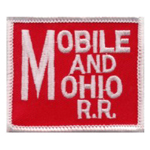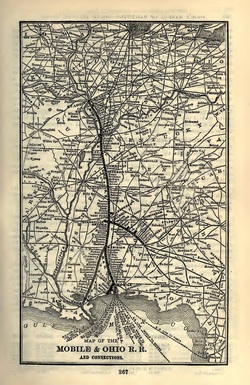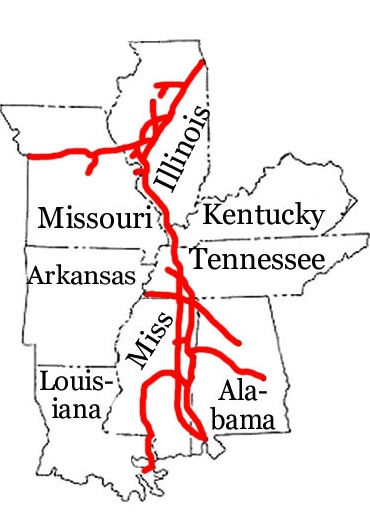ADMIRAL RAPHAEL SEMMES CAMP #11
SONS OF CONFEDERATE VETERANS
MOBILE, ALABAMA
Mobile and ohio railroad (1861-1940)

The road was chartered in Alabama, Mississippi, Tennessee and Kentucky in 1848 as a way to bypass the slow, uncertain river travel to New Orleans with fast, reliable travel to Mobile. Construction began in 1852 and was completed at Corinth, Mississippi in April 1861, creating the longest railroad under a single charter in the US.
For detailed information visit CSA Railroads.
| mobile_and_ohio_rr_financial_statement_1903.pdf | |
| File Size: | 738 kb |
| File Type: | |

This file may require Adobe Reader.
The Gulf Mobile and Ohio railroad
A Condensed History of the GM&O by Robert F. Schramm
The pre-ICG merger GM&O was composed of distinct regions, Northern and Southern. The history of each region varies to such an extent that it is best to examine each region separately.
The Southern Region
In 1848 the local businessmen of Mobile, Alabama wanted to profit from North-South trade like their river blessed neighbor to the west, New Orleans. Thus they organized the Mobile and Ohio Railroad. Progress of this line was hampered by the Civil War and the depression of 1873, and the line did not reach the Ohio River until 1883, crossing the river to North Cairo, Illinois on the Illinois Central’s river bridge. A portion of the ‘Little Giant’ narrow gauge system, the St. Louis and Cairo was purchased in 1886 and widened, thus creating a 650 mile system from St. Louis to Mobile.
Colonel William C. Falkner, A Southern Gentleman, lawyer and statesman, in 1872 chartered the Ripley Railroad Company to connect his plantation interests at Ripley, Mississippi with the Memphis and Charleston Railroad (now Southern) at Middleton, Tennessee. The Colonel soon changed the name to the Ripley, Ship Island and Kentucky, and later after a line extension through New Albany, Mississippi to Pontotoc to the Gulf and Chicago. Little did he know at the time that some day his small system would indeed reach the far shores of Lake Michigan. The line was not financially successful and later became part of the Gulf, Mobile and Northern Railroad. Colonel Falkner’s association with the early predecessor of the GM&O could be construed to be the basis for the GM&N’s title as ‘The Rebel Route’.
If any one man deserves the credit for forming the GM&O, then this credit is to go to Mr. Issac Burton Tigrett of Jackson, Tennessee. Mr. Tigrett entered railroading as a young man in 1911 when he became Treasurer and later President of a 50 mile short line between Jackson and Dyersburg, Tennessee, the Birmingham and Northwestern. After World War I he became a Director of the GM&N and at the age of 26 was appointed its temporary President.
As President of the GM&N ‘Ike’ began a period of expansion by acquiring his former B&NW, and the 25 mile Memphis and Meridian in 1925. Next came the 15 mile Jackson and Eaton to gain access to Jackson, Mississippi and also a direct connection with the New Orleans and Great Northern. However, Mr. Tigrett was not satisfied with just a connection to New Orleans, and he later leased the NO&GN, thus giving the GM&N access to the ‘River City of the South’.
In 1940 the GM&N merged with the bankrupt M&O creating a system of almost 2000 miles that connected St. Louis with the ports of Mobile and New Orleans. The Gulf, Mobile and Ohio Railroad thus was born.
The Northern Region
Alton, Illinois, located on the Mississippi about 30 miles north of St. Louis was in the early 1800’s a great river port paralleling the trade of St. Louis itself. The river many months of the year was not navigable beyond the falls up river from Alton and a direct transportation link was desired to the center and northern parts of Illinois. A local business leader named Captain James Godfrey thus obtained a State Charter in 1847 for the Alton and Sangamon Railroad, which was completed to Springfield, the state capitol, by 1852, and the name was changed to the Chicago and Mississippi.
Construction to Bloomington was completed by 1853 and to Joliet and connection with the Chicago and Rock Island by 1854. Passenger trains ran from Joliet to the Illinois Central’s Chicago depot over the Rock Island until the Rock Island’s LaSalle Street Station was completed. In 1855 the name was changed again to the Chicago, Alton and St. Louis and in 1861 to the Chicago and Alton.
The Joliet and Chicago was leased in 1864 giving the C&A access to joint owned facilities with the Pittsburgh, Ft. Wayne and Chicago Railroad (later Pennsy). Mr. Blackstone, who had been president of the Joliet and Chicago, was made president of the entire C&A, and continued as such until 1899…
During his term as president, the C&A expanded into the form it is today, with acquisition of the following properties, by construction, purchase, or perpetual lease: In 1865, the line Alton to East St. Louis, twenty-two miles, was built. Prior to this time passengers had been handled between these points by river steamers. From 1865 to 1873, passengers were taken by ferry (Wiggins Ferry Co.) across the river from East St. Louis to St. Louis, and from that time on over the famous Eads Bridge, which was completed in the latter year.
In 1868, the St. Louis, Jacksonville and Chicago line, Bloomington to Godfrey, via Roodhouse, 150 miles; 1870 Roodhouse to Mississippi River, 37 miles; 1879 Coal City Branch, Joliet to Mazonia, 24 miles; 1872 Louisiana, MO, to Mexico, MO, to Cedar City, MO, 102 miles; 1879, Kansas City, St. Louis and Chicago Railroad, Mexico to Kansas City, 161 miles; 1870 the line Dwight to Wenona (on the line to Peoria), 35 miles, was extended, Wenona to Washington, and Varna to Lacon, 10 miles soon after.
The Litchfield, Carrollton and Western crossing the main line at Carlinville, and the Godfrey line at Carrollton was purchased in 1899 and was later extended to East Hardin. Portions of the St. Louis, Peoria and Northern were purchased in 1900, and the Air Line from Springfield to Murrayville on the Jacksonville line was constructed in 1906.
On July 18, 1931 the Chicago and Alton came under the control of the Baltimore and Ohio as ‘The Alton Railroad Company’. No further expansion came about while under B&O control, and on May 31, 1947 the GM&O acquired ownership of the Alton Railroad. The consolidation of these two railroads, the Alton, and the GM&O, created a 3000 mile North-South rail system serving America’s mighty Middle States and offered a direct trunk line service between the great gateways of commerce and industry of this region.
The GM&O and its predecessors were known as leaders in the development of railroading. For example, the first Pullman sleeper, the Pioneer, was built by George Pullman in the Bloomington shops of the C&A in 1861. The first railroad dining car, the Delmonico, was built by the C&A and put into service on its line. One of the first steel bridges in the world was built by the C&A over the Missouri River at Glasgow, MO. The C&A also was the first railroad to pioneer ‘chair’ cars (reclining seats) and to operate an all Pullman train.
The GM&N was the first railroad to operate a streamline train in the South, ‘The Rebel’, and the GM&O was early to advocate the advantages of train-load or unit train movements. Thus from the early dreams of men like Falkner and Godfrey, to the able leadership of I.B. Tigrett, the GM&O became a ‘favorite’ among railroaders, historians and railroad enthusiasts as a diverse and interesting subject of study.
For more information, visit the GM&O Historical Society.
The pre-ICG merger GM&O was composed of distinct regions, Northern and Southern. The history of each region varies to such an extent that it is best to examine each region separately.
The Southern Region
In 1848 the local businessmen of Mobile, Alabama wanted to profit from North-South trade like their river blessed neighbor to the west, New Orleans. Thus they organized the Mobile and Ohio Railroad. Progress of this line was hampered by the Civil War and the depression of 1873, and the line did not reach the Ohio River until 1883, crossing the river to North Cairo, Illinois on the Illinois Central’s river bridge. A portion of the ‘Little Giant’ narrow gauge system, the St. Louis and Cairo was purchased in 1886 and widened, thus creating a 650 mile system from St. Louis to Mobile.
Colonel William C. Falkner, A Southern Gentleman, lawyer and statesman, in 1872 chartered the Ripley Railroad Company to connect his plantation interests at Ripley, Mississippi with the Memphis and Charleston Railroad (now Southern) at Middleton, Tennessee. The Colonel soon changed the name to the Ripley, Ship Island and Kentucky, and later after a line extension through New Albany, Mississippi to Pontotoc to the Gulf and Chicago. Little did he know at the time that some day his small system would indeed reach the far shores of Lake Michigan. The line was not financially successful and later became part of the Gulf, Mobile and Northern Railroad. Colonel Falkner’s association with the early predecessor of the GM&O could be construed to be the basis for the GM&N’s title as ‘The Rebel Route’.
If any one man deserves the credit for forming the GM&O, then this credit is to go to Mr. Issac Burton Tigrett of Jackson, Tennessee. Mr. Tigrett entered railroading as a young man in 1911 when he became Treasurer and later President of a 50 mile short line between Jackson and Dyersburg, Tennessee, the Birmingham and Northwestern. After World War I he became a Director of the GM&N and at the age of 26 was appointed its temporary President.
As President of the GM&N ‘Ike’ began a period of expansion by acquiring his former B&NW, and the 25 mile Memphis and Meridian in 1925. Next came the 15 mile Jackson and Eaton to gain access to Jackson, Mississippi and also a direct connection with the New Orleans and Great Northern. However, Mr. Tigrett was not satisfied with just a connection to New Orleans, and he later leased the NO&GN, thus giving the GM&N access to the ‘River City of the South’.
In 1940 the GM&N merged with the bankrupt M&O creating a system of almost 2000 miles that connected St. Louis with the ports of Mobile and New Orleans. The Gulf, Mobile and Ohio Railroad thus was born.
The Northern Region
Alton, Illinois, located on the Mississippi about 30 miles north of St. Louis was in the early 1800’s a great river port paralleling the trade of St. Louis itself. The river many months of the year was not navigable beyond the falls up river from Alton and a direct transportation link was desired to the center and northern parts of Illinois. A local business leader named Captain James Godfrey thus obtained a State Charter in 1847 for the Alton and Sangamon Railroad, which was completed to Springfield, the state capitol, by 1852, and the name was changed to the Chicago and Mississippi.
Construction to Bloomington was completed by 1853 and to Joliet and connection with the Chicago and Rock Island by 1854. Passenger trains ran from Joliet to the Illinois Central’s Chicago depot over the Rock Island until the Rock Island’s LaSalle Street Station was completed. In 1855 the name was changed again to the Chicago, Alton and St. Louis and in 1861 to the Chicago and Alton.
The Joliet and Chicago was leased in 1864 giving the C&A access to joint owned facilities with the Pittsburgh, Ft. Wayne and Chicago Railroad (later Pennsy). Mr. Blackstone, who had been president of the Joliet and Chicago, was made president of the entire C&A, and continued as such until 1899…
During his term as president, the C&A expanded into the form it is today, with acquisition of the following properties, by construction, purchase, or perpetual lease: In 1865, the line Alton to East St. Louis, twenty-two miles, was built. Prior to this time passengers had been handled between these points by river steamers. From 1865 to 1873, passengers were taken by ferry (Wiggins Ferry Co.) across the river from East St. Louis to St. Louis, and from that time on over the famous Eads Bridge, which was completed in the latter year.
In 1868, the St. Louis, Jacksonville and Chicago line, Bloomington to Godfrey, via Roodhouse, 150 miles; 1870 Roodhouse to Mississippi River, 37 miles; 1879 Coal City Branch, Joliet to Mazonia, 24 miles; 1872 Louisiana, MO, to Mexico, MO, to Cedar City, MO, 102 miles; 1879, Kansas City, St. Louis and Chicago Railroad, Mexico to Kansas City, 161 miles; 1870 the line Dwight to Wenona (on the line to Peoria), 35 miles, was extended, Wenona to Washington, and Varna to Lacon, 10 miles soon after.
The Litchfield, Carrollton and Western crossing the main line at Carlinville, and the Godfrey line at Carrollton was purchased in 1899 and was later extended to East Hardin. Portions of the St. Louis, Peoria and Northern were purchased in 1900, and the Air Line from Springfield to Murrayville on the Jacksonville line was constructed in 1906.
On July 18, 1931 the Chicago and Alton came under the control of the Baltimore and Ohio as ‘The Alton Railroad Company’. No further expansion came about while under B&O control, and on May 31, 1947 the GM&O acquired ownership of the Alton Railroad. The consolidation of these two railroads, the Alton, and the GM&O, created a 3000 mile North-South rail system serving America’s mighty Middle States and offered a direct trunk line service between the great gateways of commerce and industry of this region.
The GM&O and its predecessors were known as leaders in the development of railroading. For example, the first Pullman sleeper, the Pioneer, was built by George Pullman in the Bloomington shops of the C&A in 1861. The first railroad dining car, the Delmonico, was built by the C&A and put into service on its line. One of the first steel bridges in the world was built by the C&A over the Missouri River at Glasgow, MO. The C&A also was the first railroad to pioneer ‘chair’ cars (reclining seats) and to operate an all Pullman train.
The GM&N was the first railroad to operate a streamline train in the South, ‘The Rebel’, and the GM&O was early to advocate the advantages of train-load or unit train movements. Thus from the early dreams of men like Falkner and Godfrey, to the able leadership of I.B. Tigrett, the GM&O became a ‘favorite’ among railroaders, historians and railroad enthusiasts as a diverse and interesting subject of study.
For more information, visit the GM&O Historical Society.

